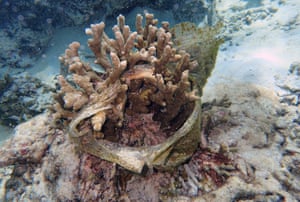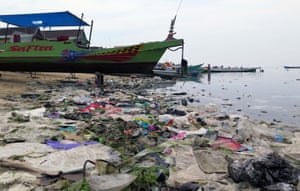Billions of pieces of plastic on coral reefs send disease soaring, research reveals

Billions of pieces of plastic on coral reefs send disease soaring, research reveals
A major new study estimates 11bn pieces of plastic contaminate vital reefs and result in infections: ‘It’s like getting gangrene,’ scientists warn

Billions of pieces of plastic pollution are snagged on coral reefs, sending disease rates soaring, new research has revealed. The discovery compounds the damage being done to a vital habitat that already faces an existential threat from the warming caused by climate change.
Scientists examined 125,000 corals across the Asia-Pacific region, home to half the world’s reefs, and found 89% of those fouled by plastic were suffering disease. On plastic-free reefs, only 4% of the corals were diseased.
The work is highly significant because it is the first to examine the impact of plastic on disease in any marine organism and also the first to produce a large-scale estimate of how much plastic pollutes the sea floor. Coral reefs in the region are contaminated with 11bn pieces of plastic, the research indicates.
At least 8 million tonnes of plastic are dumped in the ocean every year and it now pollutes even the remotest corners. Microplastics, formed when plastics are broken up, can be mistaken for food by sea creatures and early studies have shown this causes harm.
The scientists who conducted the new study did not set out to research plastic but were confronted by it across the regions they surveyed. The correlation between plastic pollution and high rates of disease was very striking and the researchers think sharp plastic fragments cut the coral organisms, while plastic fabrics smother them and block out light and oxygen.
“Corals are animals just like me and you – they become wounded and then infected,” said Joleah Lamb, at Cornell University in the US, who led the new research, published in the journal Science. “Plastics are ideal vessels for microorganisms, with pits and pores, so it’s like cutting yourself with a really dirty knife.”
During dives Lamb found objects from plastic chairs to baby nappies to a Nike-branded quick-dry towel: “I saw a big white Nike swoosh, right there where the disease was and thought, ‘oh gosh, this is not great’.”
She said that once a coral is infected, disease usually spreads across the colony: “It’s like getting gangrene on your toe and watching it eat your body. There’s not much you can do to stop it. If a piece of plastic happens to entangle on a coral it has a pretty bad chance of survival.”
Coral reefs are not only a wonder of the natural world, home to myriad spectacular creatures, but they are also vital for at least 275 million people who rely on them for food, coastal protection from storms and income from tourism. The scientists said it is “critical” to cut plastic pollution.

The international team of scientists examined corals spread across 159 reefs off the coasts of Indonesia, Thailand, Myanmar and Australia between 2011 and 2014. They found plastic snared on a third of the individual specimens, with the problem much worse on Indonesian reefs than on the Great Barrier Reef in Australia, where plastic waste is better managed.
The diseases particularly associated with plastic were skeletal eroding band disease, white syndromes and black band disease. Corals with complex branching structures, which provide crucial “nursery” niches for young fish, were eight times more likely to have entangled plastic.
The scientists were only able to record items of plastic more than 5cm in length, so did not assess the impact of microplastics. Lamb also warned: “There are a lot of other pollutants [such as toxic chemicals] in the water that are probably just as bad as plastic – you just can’t see them.”
Prof Terry Hughes, at James Cook University in Australia and not part of the study team, said: “I’d never thought of bits of plastic as a vector of disease spread from the slime that coats them, but the study shows convincingly that corals entangled in plastic are 20 times more likely to be infected.”
Earlier in January, a team led by Hughes published work warning that repeated bleaching events are now “the new normal” due to global warming and pose a fatal threat to reefs. “The new study shows that remote reefs have much less plastic and disease. Unfortunately, there’s nowhere to hide from global warming, and even the most pristine reefs are vulnerable to bleaching,” he said.

Prof Alasdair Edwards, at Newcastle University, UK, and also not involved in the new study, said the combined impact of plastic-related disease and climate change could be very serious: “Warming oceans are still the major threat to corals, but this paper shows that in areas more affected by humans, as exemplified by plastic debris, the chance of corals recovering from mass-bleaching and mortality events may be severely compromised. Corals need all the help they can get.”
Lamb said the one hopeful aspect of the plastic pollution problem was that people can take direct action: “The take-home message for individuals is to be more considered about the amount of single-use plastics you are using and think about where your plastic goes. These little things do matter.”
The researchers also estimated that the plastic pollution tarnishing coral reefs in Asia-Pacific will soar by 40% by 2025 to 16bn pieces, unless action is taken. The true number is likely to be higher, as China and Singapore were not included in the analysis.
Since you’re here …
… we have a small favour to ask. More people are reading the Guardian than ever but advertising revenues across the media are falling fast. And unlike many news organisations, we haven’t put up a paywall – we want to keep our journalism as open as we can. So you can see why we need to ask for your help. The Guardian’s independent, investigative journalism takes a lot of time, money and hard work to produce. But we do it because we believe our perspective matters – because it might well be your perspective, too.
I appreciate there not being a paywall: it is more democratic for the media to be available for all and not a commodity to be purchased by a few. I’m happy to make a contribution so others with less means still have access to information. Thomasine F-R.
If everyone who reads our reporting, who likes it, helps fund it, our future would be much more secure.


 PT
PT ES
ES FR
FR